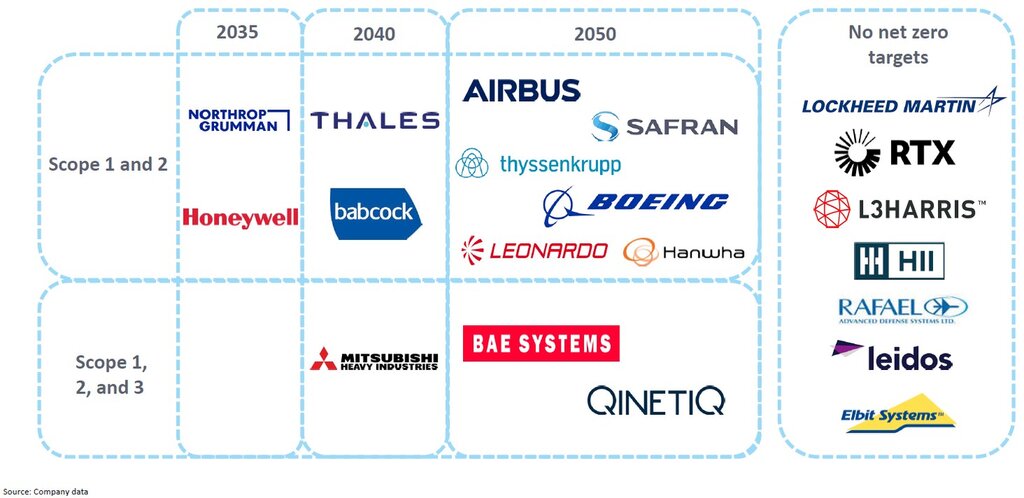Aerospace, defence and security (ADS) companies have a long way to go before reaching net zero greenhouse gas (GHG) emissions. Seven of the 20 leading ADS companies analyzed by GlobalData have not yet set a target date for reducing emissions to net zero.
Scope 1 and emissions, produced by company facilities and company-owned vehicles and the use of electricity, only make up 3% of total emissions in the ADS sector. Most emissions in the ADS sector are from aircraft built for the commercial aviation sector. These emissions, which are not created directly by the manufacturer, are known as Scope 3 emissions and are typically the most difficult for companies to measure and reduce.
Further investment in sustainable aviation fuel (SAF) and alternative fuels is a key net-zero strategy for ADS companies. SAF has the greatest potential of any current technologies to reduce emissions in the ADS industry. Other technologies such as electrification, hydrogen, and carbon capture may also have potential but are in earlier stages of development.
Who is winning the race to net zero?
Not all ADS majors have set net zero targets yet. GlobalData has analyzed the targets, emissions data, and net zero strategies of 20 leading ADS companies, listed in the graphic below.

Caption. Credit:
Most companies in the ADS sector have started reducing emissions. Out of the companies included in the chart below, BAE Systems has cut emissions by the highest percentage over the last five years. Leonardo cut its emissions by the largest proportion between 2021 and 2022, compared to the other five companies.

Caption. Credit:
Below is GlobalData’s assessment of the leading and lagging companies in the ADS sector based on the quality of their emissions disclosures as well as the clarity and feasibility of their net zero strategy.

Caption. Credit:
Key strategies for cutting emissions in the ADS sector
Electrification
Militaries are increasingly electrifying their operations, mainly in the UK and the US. Electrification can reduce emissions from existing vehicles. Some companies in the ADS sector are creating equipment that can convert vehicles from diesel- to electric-powered.
In aviation, production of unmanned electrical aircraft is increasing and there is also increasing innovation in electric vertical take-off and landing eVTOL vehicles.
Sustainable aviation fuel
The industry is transitioning to hydrogen-based fuels. Companies are promoting carbon capture and utilization and aiming to commercialize in the future. There is a push to develop clean fuels such as ammonia or biomass-fired boilers.
The development of SAFs is necessary to cut emissions in ADS, but scaling SAF production faces various logistical, macroeconomic, political, and technical challenges. SAF production so far remails low due to several market challenges, including feedstock availability, uneven market participation, regulatory complexity, policy uncertainty and technological barriers.
However, new technologies are expected to unlock future SAF supply. One method of production, known as hydrotreatment, accounts for the bulk of current SAF production, but other methods, such as alcohol to jet (ATJ-SPK), gasification, and power to liquid (PTL), will play a greater role as time goes on.
Carbon capture
While aerospace players are engaging with direct open-air carbon capture to offset emissions, maritime players are finding innovative ways of capturing sector emissions at their source. Carbon capture removes human-generated CO2 from the air and captured CO2 is then transported and stored deep underground.
Hydrogen
Hydrogen is another fuel being explored for applications across the ADS sector. Propulsion methods include hydrogen combustion, which uses hydrogen to power gas turbines with modified fuel injectors and fuel systems. Another method is hydrogen fuel cells, which create electrical energy to power electric motors that turn a propellor.
Airbus aims to bring the world’s first hydrogen-powered commercial aircraft to market by 2035 through its ZEROe project. It plans to develop four aircraft concepts powered by hydrogen.
GlobalData’s thematic analysts discuss the current state of sustainability commitments in the power, oil & gas, and mining sectors, and how companies are working to reduce their environmental impact.
Emissions across the ADS value chain
Purchased goods and services and use of sold products are the largest component of Scope 3 emissions and of ADS companies’ emissions more broadly. However, many ADS companies do not report these numbers. These companies will be less aware of potential downstream and upstream supply chain risks from emissions pricing and carbon taxes.
Scope 1 emissions in the ADS sector mainly come from estate fuel, aviation and targets fuel, vehicle diesel and petrol, and the fuel required to power industrial processes. Higher Scope 2 than Scope 1 emissions means ADS companies purchase electricity, heat, and other fueling methods at a higher volume than they emit from their own sources. Buying power can be more cost-effective for companies. ADS companies prefer to buy power rather than assume responsibility for building power generation facilities.
Most emissions in the ADS sector are Scope 3 – some 97%. Scope 3 emissions encompass indirect emissions occur in the value chain of the reporting company, including both upstream and downstream, for which the reporting company is responsible. This includes emissions produced by suppliers, when products are used or shipped, and business and customer travel.
Scope 3 emissions constitute a large proportion of total emissions from ADS companies because of the substantial emissions from commercial aircraft, manufactured by firms like Boeing and Airbus. When considering companies whose primary focus is not commercial aircraft, the use of sold products category in Scope 3 emissions still encompasses the bulk of the emissions. This includes the use of different types of military vehicles.
The proportion of Scope 3 to Scope 1 and 2 emissions will be reduced if sustainable aviation fuel is more widely adopted.
GlobalData, the leading provider of industry intelligence, provided the underlying data, research, and analysis used to produce this article.
GlobalData’s Thematic Intelligence uses proprietary data, research, and analysis to provide a forward-looking perspective on the key themes that will shape the future of the world’s largest industries and the organisations within them.
